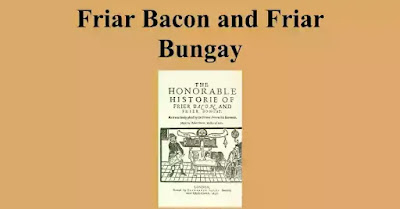Also Read
Summary
riar Bacon and Friar Bungay comedy (1589) in prose and verse by Robert Greene (one of the 'University Wits'), based on the legends of two magicians of the same names. Bacon with the help of Friar Bungay makes a head of brass and conjuring up the Devil learns from it how to give a speech to the head. It is to speak within a month but "if they heard it not before it had done speaking, all their labor would be lost." After constant watch for three weeks, Bacon hands over the duty of watching to his servant Miles and falls asleep. Then the head begins to speak successively Time is, Time was, 'Time is past, but Miles thinking that the master would be angry if he is awakened lets him sleep on. The head then falls down and breaks. Bacon on waking heaps curses on the servant. To this mediocre comedy is added the romantic story of the loves of Edward, the Prince of Wales (afterward Edward I) and Lord Lacy for the fair Margaret, the keeper's daughter. Lacy sent by the Prince to act as his go-between actually wins the heart of the milk-maid. At this the Prince becomes furious and would kill the traitor but ultimately relents and gives Margaret to Lacy. There is a scene in which Bacon, Bungay and a German magician display their respective powers before the emperor and the Kings of England and Spain.
Critical Analysis
The title is rather misleading, for the story of the magicians is altogether subsidiary. The main motif of the comedy is the love idyll of Prince Edward and Margaret. Margaret is a unique creation and in painting the character Greene shows truly Shakespearean qualities. It is a pioneering work in romantic comedy. In its variety of episodes and mingling of the characters and high characters, it anticipates the romantic comedy of Shakespeare. Margaret is the anticipation of Shakespeare's Rosalind in As You Like It.
